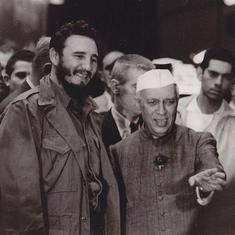“It’s not easy bowling spin, it looks like you’re just ambling up. But there’s a lot behind it,” said Ravichandran Ashwin after getting to 300 Test wickets in fewer matches (54) than anyone else during the second match between India and Sri Lanka in Nagpur.
What Ashwin said about spin bowling could be said about himself as well. Even after taking truckloads of wickets in a span so short, not many would include his name in lists of the all-time great spinners of the world or even of India.
We often talk about the famed Indian spin quartet of the 1960s and ’70s – Bishan Singh Bedi, Erapalli Prasanna, Bhagwath Chandrasekhar and Srinivas Venkatraghavan: how they were the four horsemen of the apocalypse for the visiting batters in India, how they played a big role in quenching the country’s drought of wins away. We reminisce their individual feats, we wax lyrical about the beauty of their actions, we marvel at their technical superiority.
Harbhajan Singh is out of sight now, but out of mind, he’d never be, for his hat-trick in the 2001 Calcutta epic versus Australia is an unforgettable chapter. He entered a slump in Test cricket (in mid-2011) from which he could never return, but during his peak he was rightfully celebrated and was even predicted to get close to the great Muttiah Muralitharan.
With an action that’s unassuming, without getting the ball to turn alarmingly on most occasions, Anil Kumble got to 619 wickets. Many of Kumble’s contributions, like Ashwin’s, haven’t been emphasised enough. But even for him, there are occasions – like his heroics in St John’s where he dismissed Brian Lara whilst bowling with a broken jaw – that made us revere him. Oh, there’s also that 10/74 against Pakistan at Feroz Shah Kotla.
Compared to some of their counterparts, the numbers of these aforementioned greats might not be greater. But it isn’t only the numbers that make them great – they are just an indicator. Hence, the reputations of these aforementioned greats can’t be doubted.

But none of these bowlers from India – in fact, in some cases, no one from the world – has quite managed to do what Ashwin has done over the years. He’s the joint-fourth quickest to 50 Test wickets, joint-third quickest to 100, joint-fourth quickest to 150. Only Clarrie Grimmet, before the beginning of the Second World War, took fewer games than Ashwin to reach 200 Test wickets. To 250 and 300 wickets, Ashwin beat everyone else in the history of the game.
Subtle changes
Ashwin, over the years, has learnt and unlearnt, experimented and erred, and learnt again, different aspects – like variation, load-up, point of release – of off-spin bowling. He has been mastering a craft by making changes that are subtle. He assesses the conditions, the opposition, his own bowling and comes up with a strategy, which he deems will be most effective for a particular situation.
For instance, the carrom ball, his signature delivery, he used sparsely in the last two years. The latest instance was to get Lahiru Gamage, the last Sri Lankan wicket to fall in Nagpur and Ashwin’s 300th in Tests, out and give India their biggest Test victory.
“The carrom ball was a good ball, I haven’t bowled many of those in the last 24 months,” he said after the game. “I’ve worked on different releases for it and now that we are travelling, I think I needed that extra bit.”
First week next year, he’ll be in South Africa, where, in the one match he played, he bowled 42 overs without taking a wicket in December 2013. Then, in July, he’d be in England, where he’s taken three wickets in two Tests. And then, likely towards the end of next year, he will travel Down Under, where he has, in six Tests, 21 wickets at an average of 54.71.
The moot point on Ashwin’s greatness is if he’d be able to replicate the staggering success he’s achieved at home when he travels outside India.
Well, so far, he hasn’t.
ASHWIN IN INDIA
Matches: 34| Wickets: 216| Average: 22.46| 5Ws: 20
ASHWIN OUTSIDE INDIA
Matches: 20| Wickets: 84| Average: 31.75| 5Ws: 6
But barring Shane Warne, none of the top-five spinners in the highest wicket-takers list have a better record away than at home. And 84 wickets in 20 away games isn’t a bad record. In India’s last three Test tours, he was the leading wicket-taker.
Ashwin is just 31 years and 54 Tests old. If form doesn’t elude him and injuries stay away, he will be in the international scene at least for another four to five years. That, hopefully, will be enough for him to fulfil his wish of getting to 600 wickets, better his record outside India and settle the dispute of his place among the all-time great spinners of the world.










